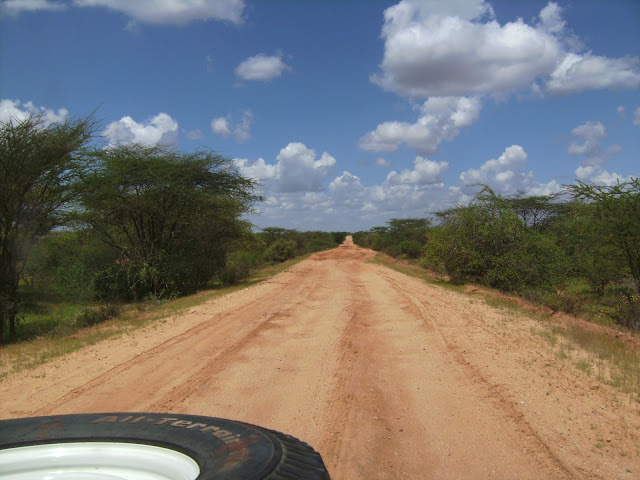This morning we headed straight for the border. Very straightforward on the Botswana side - fill out leaving forms, get passports stamped, discharge the carnet for the SADC.
You then drive to the riverfront and wonder what happens next as a small swarm of local 'businessmen' descend upon you wanting to help you through the border on the other side, bickering over who saw you first and who you should do business with. The Zambian police had recently issued a notice advising the steps you need to go through at the Zambian border and that agents were not required. Helpfully, a copy of this was posted at the Botswanan immigration and after I carefully noted it all down, we were handed a copy as we drove down to the river. When I showed this to the 'businessmen' they declared they were not agents but runners, give them the paperwork and money and they would clear it all and get us through there fast. That may be true but we had a lot of time and I'm not going to give money and passports to someone I dont know.
Somewhat confusingly, although importing and exporting Zambian kwacha is supposed to be illegal, and its also illegal to change money on the black market, you are expected to pay some of the fees in USD and some in kwacha at the border - but there are no ATMs and the one bank office I found was either closed for the day, or closed for good. We were given kwatcha by a local money-changing businessman to pay for the insurance, motor vehicle levy and carbon tax then once we'd passed out of the border control area we gave him the equivalent in USD - and the rate he charged (after a bit of negotiation) was only 4300kw to the dollar which is a damn sight better than the 3000 offered by the sharks on the Botswanan side and pretty close to the 4500 offered by the bank in Livingstone when we finally got there. We also discovered all the ATM machines in Livingstone are Visa only so had to take a credit card advance until we find a Stanbic Bank (which accepts Maestro) in Lusaka.
-------------------
For the benefit of anyone trying to figure it out (god only knows we only found conflicting information when we looked) here are the requirements as of 5 October 2009.
The first thing to note is that all payments are made on the Zambian side.
1. Immigration - we already had ours but the people ahead of us easily purchased their visa at the border USD $50.00 each, although we had already sorted ours out in Windhoek.
2. Ferry fees - the notice said these were payable at the office on the other side, but we were asked for them as the ferry was crossing. It took a while for the ferry official to convince me, but his receipt book printed with the same name of the company as on the police notice did the trick. USD $20.00
3. Carbon Tax. This is payable in the two windows to the left of the two immigration windows. Unless you have a carnet (which we did) in which case you go through the office you're in down a corridor to the building behind, past the defunct bank to an office on the left. These differ according to the spec of your vehicle. The Landy is 2.5 litres and it cost us ZAK 150,000.00.
4. 3rd Party Insurance. If you dont already have this, you can purchase it on the other side of the border gate at a caravan on the left. Weirdly no one stops you walking through or checks your passport. Then you can walk back in to continue the paperwork shuffle. One month 3rd party insurance for the Landy cost ZAK 112.00.
5. Road Transport Permit. These are USD $20.00 within Zambia or $40.00 if you're going to Malawi. It seems the fees are return if you're going to Malawi, that is they assume you'll be coming back so take the payment all in one go. When the clerk realised we wouldnt be coming back through Zambia he charged us $20.00 and wrote a note on the receipt to show at the border when we exit Zambia. You need to already have paid the carbon tax and have insurance before you can get your road permit.
6. Council Office - Motor vehicle levy. Pay this ZAK 20,000.00 at the building marked 'police'.
Then get back into your vehicle and join the queue for the exit gate. Various people will come to check for different receipts before you can drive out, so keep them on hand.
You can extend the insurance and get a yellow Comesa card at the branch of the insurance company on the main road in Livingstone. This means you dont have to take out a months insurance at every border crossing up the east side of Africa to the Sudan.
 Stopping for the night was the right decision and it is a very pretty location but I think we both regretted it as crowds of drunken revellers enjoying loud music with thumping bass kept us awake most of the night. I guess its a popular Saturday night spot although they charge a lot for camping and charge extra if you want to cook your own food!
Stopping for the night was the right decision and it is a very pretty location but I think we both regretted it as crowds of drunken revellers enjoying loud music with thumping bass kept us awake most of the night. I guess its a popular Saturday night spot although they charge a lot for camping and charge extra if you want to cook your own food!



_cropped_shrunk.JPG)















